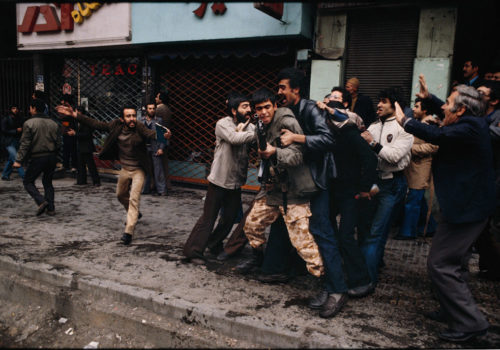American David Burnett is probably best known as a conflict photojournalist whose seminal work on the 1979 Iranian Revolution still stands up today as cutting edge photojournalism. “I had a few exclusives,” he said of the heady days flying around the world covering major events for international publications. “In Iran I talked my way in to see the Ayatollah Khomeini after he’d been in Paris. The first picture I took was of him putting a teacup back on the tray. That was a moment that showed a whole other side to that leader at the time”.
Burnett, who has been shooting for forty years, is also the co-founder of New York’s Contact Press Images. His oeuvre is vast spanning a diversity of topics, which is evidenced in a new book published by Reporters Without Borders “100 Photos for Freedom of the Press” featuring “a whole career’s worth” of Burnett’s work.
Selecting images to exhibit when you have thousands to choose from must be a daunting task. I ask Burnett why he chose his photo essay on Bob Marley for Reportage. “He’s a lodestone figure, he crossed all cultures, all languages, politics. He is seen as a very special figure,” he explained.
Burnett said when he first went to Jamaica in 1976 “I don’t know if I’d even heard of Bob Marley. We had a long interview with him for Time magazine in Kingston. I was hopping around the room shooting Bob while he was being interviewed. I’ve been an available light guy my whole life. There was something magical about shooting on film, when we didn’t know we had a picture…I didn’t really listen to the interview, my concentration was going through the viewfinder, but what I did hear, I kept thinking there’s something really special about this guy”.
“I remember thinking at the time, I am about the same age as this guy, and he’s so wise. He had a wisdom born from having paid attention to so many things that had happened in his life. That was the most interesting impression I had of him. Intelligent, knows how to synthesize all he sees, poverty, politics and all that he knew”. A year later Burnett was on the road with Bob Marley and the Wailers in Europe for Rolling Stone magazine. “I was happy to be there”.
Talking to Burnett about his archive it is clear he laments the passing of film. I ask him what he thinks of the trends in photography today and whether the traditional role of the photojournalist is still relevant.
“Ten years ago photographers needed to know what an f-stop was and shutter speed, but nowadays you don’t seem to need to understand the technical aspects of photography in the same way,” he said. “Everyone is a photographer, everyone has a phone with a camera, so there is an explosion of pictures. But finding pictures in the giant morass of imagery that is online, just trying to swim through it as a viewer is very tough”.
“We may end up with the most amazing visual generation ever because they are unencumbered by the issues we had to deal with. A lot of photographs are taken now that couldn’t have been done before, but the downgrading of the discipline of photography, waiting for the right moment to shoot, blending your eye with technology and technique, knowing that less is more, and that it is not all about speed and how fast you can upload an image, these are the real shifts.”
Burnett said he comes from the “old Life magazine” philosophy of visual storytelling, where the objective is to capture images that will shed light on events and situations that “the forces of darkness want to shut out. But if we are going to rely on having free societies then these stories need to be told and I think there is great value still in having professional journalists including photographers to tell them”.
Soul Rebel: An Intimate Portrait of Bob Marley’
Until 22 June, 2013
Blender Gallery
16 Elizabeth Street Paddington
Australia
Burnett is also exhibiting “The Presidents: From JFK to Obama”
June 1-August 18
Australian Centre for Photography
257 Oxford Street, Paddington
Australia
Reportage Projections – check the website for locations
Alison Stieven-Taylor
















